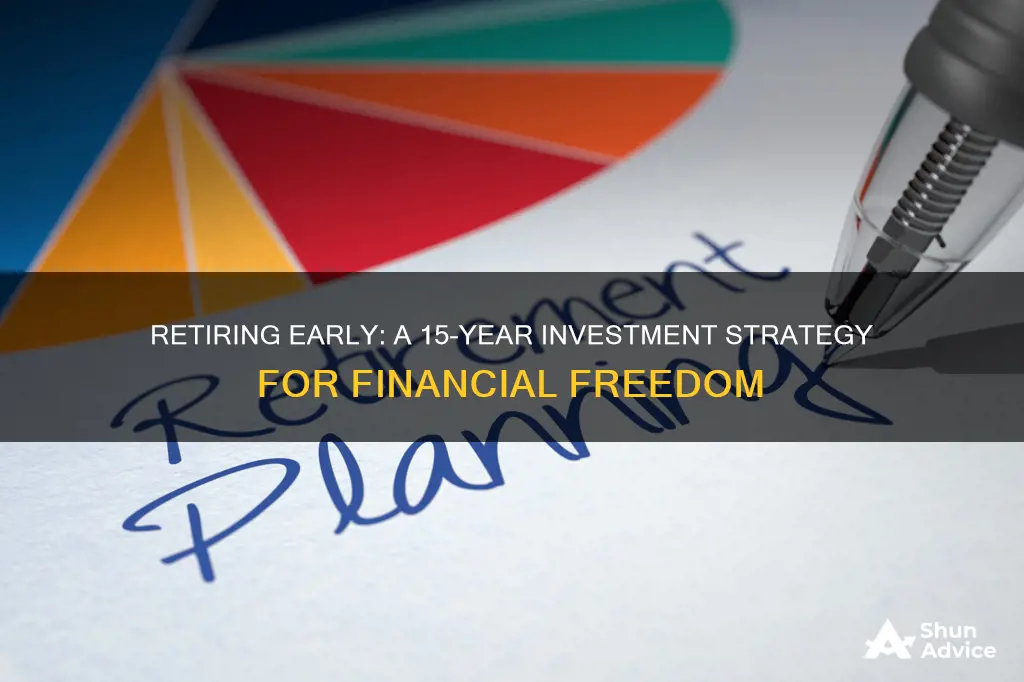
If you're looking to retire in 15 years, you'll need to start planning now. The first step is to assess your current financial situation, including your income, expenses, and savings. From there, you can start to set goals and create a plan to ensure you're on track to meet them. This may involve creating a budget, maximising your contributions, and reviewing your portfolio's risk exposure. It's also important to consider all sources of income, including Social Security, pensions, and any part-time work you may take on during retirement. While it's never too late to start planning for retirement, those closest to retirement may need to consider more conservative investments to preserve their savings. Seeking advice from a financial advisor can also help you make the most of your investments and feel secure in your decisions.
| Characteristics | Values |
|---|---|
| Timeframe | 15 years |
| Action | Save aggressively |
| Social Security | Income will depend on your earnings and when you claim benefits |
| Pension | Monthly payments for life |
| Part-time work | Working part-time for a few years can make a big impact |
| Savings | Save at least 15% of your salary |
| Investments | Spread your investments across growth and income, growth, aggressive growth, and international mutual funds |
| Risk | Take a measured approach to risk |
| Retirement age | The longer you wait, the more guaranteed income you receive |
What You'll Learn

Create a retirement budget
Creating a retirement budget is an important step in planning for your retirement. It will help you to understand how much money you will have to spend and ensure that you don't run out of savings. Here are some steps to help you create a retirement budget:
Calculate your income streams:
Firstly, you need to add up all your sources of income during retirement. This includes tax-advantaged retirement accounts such as 401(k), 403(b) or a Roth IRA, social security benefits, pension plans, part-time earnings, taxable investments, real estate income, and annuities. Calculate your projected income from these sources and divide it by the number of years you plan to live in retirement to get a ballpark figure for your annual income.
Plan your distributions:
Your 401(k) or IRAs will likely be your biggest source of income. Planning when, how, and from which accounts you'll take distributions is crucial. It is recommended to work with an investment professional to navigate all the debates about how much and when to withdraw. The main thing is to ensure you don't withdraw too much and stop the growth of your investments.
Consider healthcare expenses:
As you age, healthcare costs will likely increase. It is important to have a plan for these expenses, including insurance coverage, long-term care insurance, and Medicare. Talk to an insurance professional to understand your options and the potential costs.
Create a zero-based monthly budget:
A zero-based budget helps you plan for all your expenses and ensures that you are spending, saving, or giving every dollar a purpose. Write down your monthly income and expenses, including essential and non-essential expenses. Essential expenses include housing, transportation, groceries, and bills, while non-essential expenses might include subscriptions, hobbies, and dining out.
Track your spending:
Review your bank statements to see where your money is going. This will help you identify areas where you may be able to cut back if needed. It is important to be intentional about your spending and stick to your budget to ensure your retirement savings last.
Adjust and monitor your budget:
Your expenses and income may change over time, so it is important to regularly review and adjust your budget. This might include cutting back on non-essential expenses or finding ways to increase your income if needed.
Retirement planning can be complex, and it is always recommended to seek professional financial advice to ensure you are making the best decisions for your unique situation.
Smart Ways to Invest $5K
You may want to see also

Maximise contributions
Maximising contributions to your retirement savings is a smart way to help close the retirement gender gap. Here are some ways to maximise your contributions:
Contribute to your workplace retirement account
If you have a retirement plan through your employer, such as a 401(k) or 403(b), find out if your employer will match your contributions up to a certain amount each year. This amount might be a percentage of your contributions, a percentage of your salary, or a set dollar amount. Once you know their policy, do the math to understand how much you need to contribute to reach the maximum employer match. This is essentially free money, so you don't want to miss out on it.
Contribute to a health savings account (HSA)
Consider using a health savings account (HSA) if you are enrolled in an HSA-eligible health plan. With an HSA, you can often split your contributions into invested money (which can be used for long-term savings for health care costs in retirement) and cash (which you can use to pay for qualified medical expenses directly from your account). You can get three tax benefits for contributions: an initial tax deduction for your contributions, tax-free potential earnings, and tax-free withdrawals when you use the money for qualified medical expenses. For 2023, the contribution limit is $3,850 for individuals or $7,750 for families; those 55 and older can contribute an additional $1,000 as a catch-up contribution.
Contribute to a workplace savings plan
If you've contributed up to your employer's match, you may be ready to save more for retirement. Consider maxing out your 401(k). In 2024, you can contribute up to $23,000 pre-tax to your 401(k). If you're at least 50 years old at the end of the calendar year, you can add a catch-up contribution of $7,500 pre-tax.
Contribute to an IRA
Another option is to contribute to an individual retirement account (IRA). These are not connected to an employer, and you can contribute in addition to your employer's plan. There are several IRA options, with different benefits and requirements. You can contribute to one or even several of these options, as long as your combined contributions don't exceed your earned income or the IRS limit. For 2023, the limit is $6,500, or $7,500 if you are 50 or older.
Add after-tax money to your 401(k)
Your employer might allow you to add after-tax money to your 401(k), in which case you can contribute beyond your individual limit and go up to the 2023 combined employer and employee limits of $66,000 or $73,500 if you're 50 or older.
Invest in brokerage accounts
You can also save and invest in regular brokerage accounts. The tax advantages won't be the same, but you'll still have the potential for long-term growth, and there's no limit to how much you can invest.
Make sacrifices in the present
If you can afford it, it is in your best interest to contribute additional funds to your superannuation. Because these additional commitments can be tax-deductible, the amount of money you are setting aside will be notably less in practice than it appears on paper.
Track down and combine accounts
If you have multiple superannuation accounts, you can increase the rate your super grows each year by tracking them down and combining them. This is due to the compounding effect of additional funds and reduced fees. Just be sure to check that no benefits are lost by transferring to your chosen fund.
Use tax deductions
If your spouse earns less than $37,000 per year, any contributions you make to their superannuation can be deducted from your own tax obligations. Other common deductions include the ability to contribute directly from your bank account to your fund and claim a tax deduction.
Take advantage of catch-up concessional contributions
The government has introduced a "catch-up" concessional contribution, which makes it possible for individuals to grow their super by utilising unused concessional contribution caps within the next five years. For example, if you only contribute $15,000 towards the concessional contribution cap of $25,000 in one year, in the next year you will have an additional $10,000 you can contribute, taking your cap to $35,000 for that year.
Make a plan for your estate
It can be difficult to talk to loved ones about preparations for when you're gone, but leaving things to chance can cause greater emotional and financial stress on your family. Start having financial and health conversations with your family, and consider creating a will, pre-paying your funeral expenses, or putting a trust in place to take care of family members.
Investments: Paying with Potential
You may want to see also

Start estate planning
While it may seem like a morbid chore, estate planning is an important step in retirement planning. It ensures that your financial affairs are in order and that your wishes are legally binding. Here are some steps to help you start estate planning:
Create a Will:
A will is a legal document that outlines your wishes for your assets after your death. It is important to have a will in place, regardless of your net worth. Without a will, your assets will likely go through a probate process, which can be confusing and time-consuming for your loved ones. Consult a legal professional to help you draft a will that reflects your wishes.
Assign Power of Attorney:
Granting power of attorney gives someone you trust the authority to manage your financial affairs if you become unable to do so. This can provide peace of mind and ensure that your financial matters are handled according to your wishes.
Healthcare Directives:
Consider creating a living will or advance directive, which outlines your wishes for medical care if you become unable to communicate them. You can also appoint a healthcare proxy or healthcare power of attorney, who will make medical decisions on your behalf if you are unable to do so. Ensure that your family and healthcare providers have copies of these documents.
Review and Update Beneficiaries:
If you have retirement accounts such as IRAs or employer plans (e.g., 401(k)s), review the designated beneficiaries. Ensure that the information your financial institutions have on file is up to date and reflects your current wishes.
Consider a Trust:
If you want more control over how your assets are distributed, consider setting up a trust. A trust can provide privacy, lower taxes on your estate, and allow you to appoint a corporate trustee to handle administrative tasks. Consult a financial adviser to determine if a trust is right for your situation.
Organize Financial Information:
Create a comprehensive packet of your financial information, including account details, insurance policies, and any other relevant documents. Make sure your loved ones know where to find this information, making it easier for them to manage your affairs if needed.
Crypto Investments: Legal or Not?
You may want to see also

Review portfolio's risk exposure
When reviewing your portfolio's risk exposure, it's important to understand the fundamental relationship between risk and reward. While investing in financial markets can carry significant risks, not taking any risks may also result in missed opportunities for higher returns. Therefore, it is crucial to find the right balance between risk and reward by optimising your portfolio's risk exposure.
Firstly, it is essential to recognise that the proportion of a portfolio allocated to equities is the key determinant of its risk profile. In general, a low-risk portfolio typically consists of 15-40% equities, while a medium-risk portfolio ranges from 40-60%, and a high-risk portfolio is usually 70% or higher. It is worth noting that the remainder of the portfolio is often composed of lower-risk asset classes, such as bonds, money market funds, property funds, and cash.
Additionally, it is important to be cautious of firms and advisors who might suggest a higher-risk portfolio to generate more profits. In reality, a portfolio that is predominantly made up of equities and marketed as medium-risk rarely happens. Therefore, it is crucial to assess the percentage of equities in the total portfolio to gain a more accurate understanding of the risk level.
Furthermore, it is worth considering your risk tolerance and time horizon. As you approach retirement, you may want to reduce your exposure to stocks to avoid risking money intended for short-term use. However, with rising life expectancies, some investors opt to maintain or increase their equity holdings even as they near retirement age. Ultimately, the decision to take on more risk should be aligned with your risk tolerance and how well you can sleep at night during market downturns.
To make informed decisions, utilise tools like Qtrade's Portfolio Analytics to better understand your portfolio's risk exposures. By conducting regular reviews, you can ensure that your portfolio's risk level aligns with your desired level of risk and make adjustments as necessary. Remember, investing carries inherent risks, and diversification and asset allocation strategies can help improve returns and mitigate risks.
Smart Money: Where's It Going?
You may want to see also

Assess your current situation
Before you start planning for retirement, it's important to take stock of your current financial situation. This means being honest about how much you've saved so far and what your sources of income are. It's also important to consider your retirement goals and budget, as well as the age at which you want to retire.
Start by calculating your total savings across all accounts, including individual retirement accounts (IRAs) and workplace retirement plans such as a 401(k) or 403(b). If you have taxable accounts that you plan to use specifically for retirement, include those too. However, don't factor in money saved for emergencies or large purchases, such as a new car. This will give you a clear picture of your current financial position and help you identify any gaps between your savings and your retirement goals.
Next, consider your sources of income during retirement. This could include Social Security benefits, pension plans, and income from part-time work. Think about your expected spending habits during retirement, including housing, food, dining out, leisure activities, and health and medical expenses. Creating a monthly budget will help you estimate your regular expenditures and identify any areas where you can cut back.
It's also important to think about your timeline for retirement. Are you hoping to retire early, or are you planning for a longer-term retirement that could last three decades or more? This will impact the size of the retirement portfolio you'll need to build.
Finally, assess your risk tolerance. As you approach retirement, it's generally recommended to adopt a more conservative investment strategy to preserve your savings. Consider gradually shifting your portfolio towards more stable, low-earning funds like bonds and money market funds.
Calculating Investment Returns: A Comprehensive Guide
You may want to see also
Frequently asked questions
This depends on a number of factors, including your current income, lifestyle, and expenses. A common rule of thumb is that you should save enough to maintain your current lifestyle, which is estimated to be somewhere between 70% to 80% of your current income.
This depends on your age, risk tolerance, and financial goals. Generally, younger investors can tolerate more risk and invest more in stocks, while older investors may want to focus on more stable, low-earning funds like bonds and money market funds. It's important to assess your risk tolerance and create a diversified portfolio that aligns with your goals.
This depends on your income, expenses, and desired retirement age. A good rule of thumb is to save at least 10-15% of your income, with the percentage increasing by 10% for every decade you delay saving. If you're closer to retirement, consider saving more aggressively or taking on a part-time job to boost your savings.
In addition to your savings and investments, you may receive income from Social Security, pensions, part-time work, or the sale of property. It's important to consider these sources when planning for retirement and ensure you have enough income to cover your expenses.







